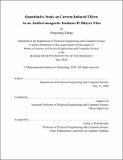| dc.contributor.advisor | Luqiao Liu. | en_US |
| dc.contributor.author | Zhang, Pengxiang(Electrical engineer and computer scienctist). | en_US |
| dc.contributor.other | Massachusetts Institute of Technology. Department of Electrical Engineering and Computer Science. | en_US |
| dc.date.accessioned | 2020-09-15T21:50:12Z | |
| dc.date.available | 2020-09-15T21:50:12Z | |
| dc.date.copyright | 2020 | en_US |
| dc.date.issued | 2020 | en_US |
| dc.identifier.uri | https://hdl.handle.net/1721.1/127283 | |
| dc.description | Thesis: S.M., Massachusetts Institute of Technology, Department of Electrical Engineering and Computer Science, May, 2020 | en_US |
| dc.description | Cataloged from the official PDF of thesis. | en_US |
| dc.description | Includes bibliographical references (pages 72-76). | en_US |
| dc.description.abstract | Electrical control and detection of magnetic ordering inside antiferromagnets have attracted considerable interests, for making next generation of magnetic random access memory with advantages in speed and density. However, a full understanding of the recent prototypical spinorbit torque antiferromagnetic memory devices requires more quantitative and systematic study. In this thesis, we study the current-induced switching in a canted antiferromagnetic insulator [alpha]-Fe2O3. The (0001) oriented films were epitaxially grown on [alpha]-Al2O3 substrates, and a Pt layer was sputtered to apply an electric current and detect the magnetic states of [alpha]-Fe2O3 through antiferromagnetic spin Hall magnetoresistance. We performed the conventional current-induced switching tests for antiferromagnetic memory devices and obtained a similar sawtooth-like behavior. Using the uniquely small spin-flop field of [alpha]-Fe2O3, we compared the current-induced Hall resistance to the field-induced one, and analyzed the nature of the switching. We raise the concern that the signal in these memory devices can be complicated by two neglected sources that are unrelated to spin-orbit torques: a purely resistive switching effect, and a current-induced magnetoelastic effect. The contributions from spin-orbit torques, however, are much smaller than previously expected. For the on-going research of current-induced antiferromagnetic switching, our work provides a promising material platform, demonstrates a quantitative analysis method, and reveals the dominant but previously-unknown mechanisms of the switching phenomena. Therefore, our work may provide a pathway towards the clear realization of a spin-orbit torque antiferromagnetic insulator memory device. | en_US |
| dc.description.statementofresponsibility | by Pengxiang Zhang. | en_US |
| dc.format.extent | vi, 76 pages | en_US |
| dc.language.iso | eng | en_US |
| dc.publisher | Massachusetts Institute of Technology | en_US |
| dc.rights | MIT theses may be protected by copyright. Please reuse MIT thesis content according to the MIT Libraries Permissions Policy, which is available through the URL provided. | en_US |
| dc.rights.uri | http://dspace.mit.edu/handle/1721.1/7582 | en_US |
| dc.subject | Electrical Engineering and Computer Science. | en_US |
| dc.title | Quantitative study on current-induced effects in an antiferromagnetic insulator/Pt bilayer film | en_US |
| dc.type | Thesis | en_US |
| dc.description.degree | S.M. | en_US |
| dc.contributor.department | Massachusetts Institute of Technology. Department of Electrical Engineering and Computer Science | en_US |
| dc.identifier.oclc | 1191843988 | en_US |
| dc.description.collection | S.M. Massachusetts Institute of Technology, Department of Electrical Engineering and Computer Science | en_US |
| dspace.imported | 2020-09-15T21:50:12Z | en_US |
| mit.thesis.degree | Master | en_US |
| mit.thesis.department | EECS | en_US |
